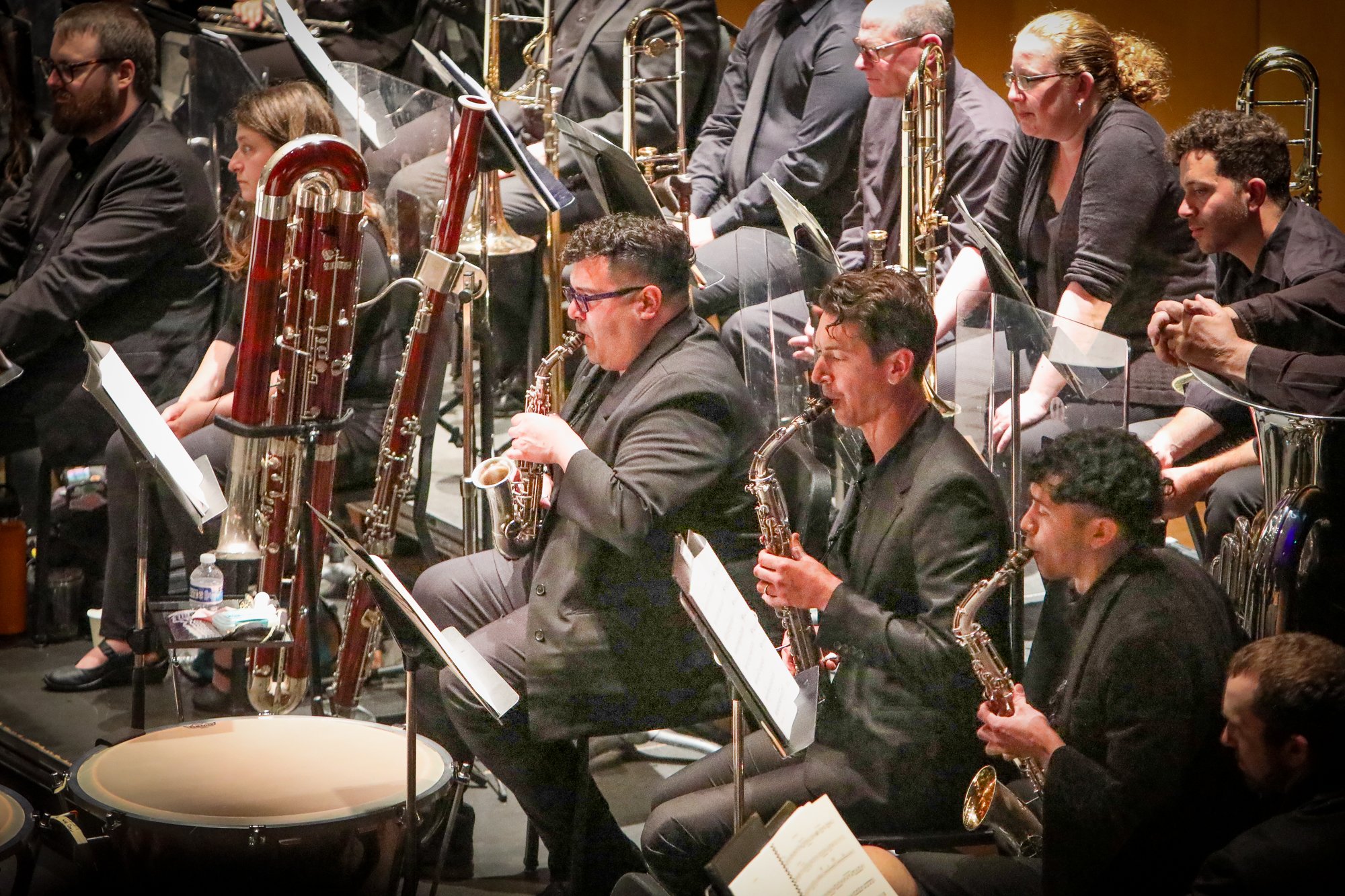“He’s the GOAT!” someone posted about John Williams in an online film composers’ forum. No one disagreed. (GOAT stands for “greatest of all time” — I should explain for readers who are not texting four-letter acronyms on their smartphones all day!) In his brief introductory remarks at Santa Cruz Symphony’s final concert of the 2023-2024 season, Maestro Daniel Stewart hailed John Williams not just as a great film composer but as “the greatest living composer.” While we each might have our personal favorite living composer and favorite film composer, it is hard to argue with the assessment that John Williams is the greatest in both categories. To put it simply: if he isn’t, then who is?
Professor and Reviewer Martin Gaskell
John Williams, who is now 92, has composed music for more than 120 movies, with release dates going from 1954 all the way up to last year’s Indiana Jones and the Dial of Destiny. Not only is the music of John Williams extremely popular, but it has also been highly influential. He continues to be widely studied and emulated by the younger generation of film and video game composers. In this regard, the position of John Williams parallels the influence of Beethoven on composers in the 19th century.
Why is the music of John Williams so great? I believe the answer is because he excels in all the basic elements of music: rhythm, melody, harmony and instrumentation. In particular, unlike many composers, he is not afraid of having clear rhythms and motifs or of having melodies.
John William’s music is a vital part of movies. For example, the triumphant “throne room” scene, which concludes the 1977 Star Wars movie and was the last piece in Saturday’s concert, sounds very cold and even sinister without the music. (You can hear the scene without the music at https://www.youtube.com/watch?v=HM5QfBtMSYM.) On the other hand, as was obvious on Saturday, all of John William’s music stands alone well in the concert hall without the movies it was written for.
The atmosphere on Saturday night was the most festive I have seen at an orchestral concert. The orchestra had organized a street party outside the Civic to precede the concert, so a festive mood was already set. Star Wars costumes and light sabers abounded. Inside the auditorium, even the routine pre-concert recorded announcement to make sure that cell phones were silenced drew applause. So too did the announcement by Symphony Board President Linda Burroughs that the concert was sold out — something already obvious simply by looking around the 2000-seat auditorium.
Obviously, a single concert can only present a few highlights from the enormous output of John Williams. The program was very well planned and balanced. For the first half Maestro Stewart chose well-known but contrasting selections from half a dozen movies showing the range of Williams’s talent. The concert opened with the march from the 1981 movie Raiders of the Lost Ark. In contrast to a typical orchestral concert, the audience on Saturday freely expressed itself throughout the program rather than just at the end of pieces. For example, there was clapping after the opening rhythm of the Raiders march as the unison trumpets came in with the march theme. Needless to say, after the stirring conclusion of the march, the audience’s response was ecstatic.
Daniel Stewart opted to perform the selections in the first half in a different order from what had been printed in the program. The Raiders march was followed by first horn Scott Hartmann playing the calm horn solo that opens the main theme to Jurassic Park (1993). Hartmann was repeatedly feted by the audience throughout the evening when called for solo bows at the ends of pieces. The horn theme is followed by a beautiful broad theme on the violas. As the movement progresses, it becomes more and more wild — a characteristic of a number of John Williams pieces. At the conclusion the audience was again ecstatic.
A complete contrast to the wild ending of the Jurassic Park theme was provided by Kiefer Taylor’s extended celeste solo that starts Hedwig’s theme from Harry Potter and the Sorcerer’s Stone. This utterly enchanted start produced gentle exclamations of “oooh!” from the audience.
Unlike the first three selections, the whimsical opening title sequence from the 2002 movie Catch Me If You Can is very lightly scored. In the movie both the opening credits and the accompanying music of John Williams pay homage to The Pink Panther and its classic Henry Mancini score. The opening of Catch Me if You Can starts with just a single, quiet unison note on marimba, vibes, piano and clarinet. This develops into figures for the clarinets (Karen Sremac and Art Austin). This is interrupted by the rest of the orchestra very unexpectedly whispering “shhh!” a couple of times. Since audiences are used to orchestral players never saying anything during a performance, this is a bit startling. It is also unusual from the players’ perspective, because speaking during a piece is something that does not come naturally when one’s entire training has been to sit quietly!
At the heart of this gem of a piece are alto saxophone solos, played by Michael Hernandez. When the main clarinet figure returns, John Williams has players do another thing orchestral players never do in a concert: snap their fingers. This is actually quite hard for instrumentalists because their hands need to be in very specific positions for holding up and playing their instruments.
The penultimate John Williams piece for the first half of the concert was the theme from the 1993 film Schindler’s List. After an introductory theme played on the cor anglais (Coreen Levin) with the violas, the celebrated extended violin solo was played by Artist in Residence and Concertmaster Nancy Zhou. As always, the strings of the orchestra kept a perfect balance to let the solo shine through. The audience was enraptured throughout. Ms. Zhou must be especially commended for her exquisite artistry in the ending where the solo violin rises up pianissimo to the highest note in the piece. The execution of this was perfect. Ms. Zhou achieved just the right level of pianissimo for the large auditorium and left the audience spellbound. As the sound faded out there were appreciative sounds of “aahhh…” from the audience. This was then followed by vigorous applause. Not only was the audience clapping, but so were orchestra members who were clearly impressed with their leader’s interpretation.
With “Adventures on Earth” from E. T. we were back to the powerful style we associate with John Williams. This piece included some fine playing on the G string by the first and second violins. The first violins are to be commended for playing so strongly throughout the concert as there were only eight of them. At the end of the piece there were shouts of “woo-hoo!” and the waving of lightsabers.
The first half ended with a surprise that was not in the program: the winner of the 2023 auction to conduct the orchestra, Mary Rose Mackenzie, conducting John Philip Sousa’s march “Stars and Stripes Forever.” Mary Rose’s conducting brought the house down! When she mounted the conductor’s platform and turned to face us with the baton in her mouth like a brigand who had just scaled a cliff, we knew we were in for quite a ride! Red and blue lights with red streamers lit up the back wall of the Civic and the orchestra was off. Maestro Danny could perhaps learn a few things from Mary Rose about baton technique! She used her baton for stabbing at the orchestra, for playing like a piccolo, and, in the famous “dogfight” interlude (so called because of its resemblance to World War II aerial combat), she used the baton as a machine gun to gun down the orchestra! (I’m not sure what the best response of players to such a cue is! Duck and cover maybe?) On the first appearance of the “Oh, be kind to your friends in the pond” theme of the middle section, a waving star-spangled banner appeared on the screen and the audience clapped.
For the sparkling piccolo obbligato, the three players (Sarah Benton, Kris Palmer and Marian Concus) stood up, a tradition that traces back to Sousa himself. On the Grandioso return of the central theme the whole audience clapped along. The ovation at the end was deafening. One audience member remarked that Mary Rose’s conducting was the best conducting of “Stars and Stripes Forever” she had ever seen!
The second half, devoted entirely to music from the Star Wars films, began — to much waving of lightsabers around the semi-darkened hall — with the title theme to the 1977 original. This was followed with Anakin’s theme from The Phantom Menace and the love theme “Across the Stars” from Attack of the Clones. The latter started with a lovely oboe melody played by Maeve Cox.
No program of music from Star Wars could possibly be complete without the famed “Imperial March” of the bad guys from The Empire Strikes Back. The instantly recognizable rhythmic motif that underlies the march caused immediate acclamation. A sinister-looking, blood-red, six-spoked Imperial Crest appeared on the screen behind the orchestra — a masterful touch. At the end of the march there were shouts of “Woo hoo!” from the audience and loud applause. When Daniel Stewart had all the brass on the back row stand for a bow there was loud cheering and thunderous applause. The “Here They Come” battle scene music from The Empire Strikes Back was a natural follow-on to the “Imperial March.”
John Williams is popularly associated with music for heroic battle scenes in epic blockbusters, but his father was a noted jazz drummer and percussionist. Back in the 1950s, Williams himself released several jazz albums. His jazz background comes to the fore in the Cantina Band music in the brilliant spaceport-bar scene in the original 1977 Star Wars movie. This was played by the trio of saxophones and a jazz ensemble subset of the orchestra with principal percussionist Norman Peck laying down the beat. Players who were not involved were sitting back and moving in time to the music in obvious delight. To give a little of the atmosphere of a spaceport bar, yellow, green, and blue/purple lights were shone on the back wall. In jazz style, soloists were recognized by the audience as they finished their solos. A bass player gave his instrument a celebratory spin. There was big applause at the end.
The lighting turned to green as the horns and cellos and then the whole orchestra took up the broad “Yoda’s Theme” from The Empire Strikes Back. The tranquility of this was a good preparation for the grand finale of the concert: the triumphant, Elgarian “Throne Room Scene” finale to the 1977 movie. At the end there was loud cheering and everyone in the auditorium was up on their feet straight away in a standing ovation. The audience also enthusiastically expressed their appreciation of many individuals and groups as Daniel Stewart called on them to take solo and group bows. The three saxophonists and the five percussionists and timpanist were clearly particular favorites of the audience.
And so, as the prolonged applause finally died out, an amazing evening came to an end. How can I best sum it up? Perhaps simply by saying: yes, John Williams is the indeed the GOAT!
~ Professor Martin Gaskell



















